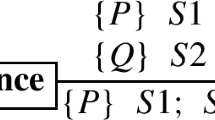Abstract
The paper presents a critical examination of the way certain central aspects of concurrent programs are formally modeled. The main formal model examined is the operational model of fair transition system which represents concurrency by interleaving of actions considered atomic. Several questions concerning the faithfulness of this representation naturally arise. The paper considers some of these questions and, while presenting and analyzing some of the alternatives, attempts to justify the design decisions actually taken in the construction of the model.
This research was supported in part by the National Science Foundation under grants CCR-89-11512 and CCR-89-13641, by the Defense Advanced Research Projects Agency under contract N00039-84-C-0211, by the United States Air Force Office of Scientific Research under contract AFOSR-90-0057, and by the European Community ESPRIT Basic Research Action Project 3096 (SPEC).
Preview
Unable to display preview. Download preview PDF.
Similar content being viewed by others
References
E. Dijkstra. Guarded commands, nondeterminancy, and formal derivation of programs. Comm. ACM, 18(8):453–457, 1975.
E. Dijkstra. A Discipline of Programming. Prentice-Hall, New Jersey, 1976.
J. Fetzer. Program verification: The very idea. Comm. ACM, 31:420–422, 1988.
D. Harel and A. Pnueli. On the development of reactive systems. In Logics and Models of Concurrent Systems, pages 477–498. Springer-Verlag, 1985.
Z. Manna and A. Pnueli. How to cook a temporal proof system for your pet language. In Proc. 10th ACM Symp. Princ. of Prog. Lang., pages 141–154, 1983.
Z. Manna and A. Pnueli. The anchored version of the temporal framework. In J. de Bakker, W.-P. de Roever, and G. Rozenberg, editors, Linear Time, Branching Time and Partial Order in Logics and Models for Concurrency, pages 201–284. Lec. Notes in Comp. Sci. 354, Springer-Verlag, 1989.
A. Pnueli. Applications of temporal logic to the specification and verification of reactive systems: A survey of current trends. In J. de Bakker, W.-P. de Roever, and G. Rozenberg, editors, Current Trends in Concurrency, pages 510–584. Lec. Notes in Comp. Sci. 224, Springer-Verlag, 1986.
Author information
Authors and Affiliations
Editor information
Rights and permissions
Copyright information
© 1991 Springer-Verlag Berlin Heidelberg
About this paper
Cite this paper
Manna, Z., Pnueli, A. (1991). On the faithfulness of formal models. In: Tarlecki, A. (eds) Mathematical Foundations of Computer Science 1991. MFCS 1991. Lecture Notes in Computer Science, vol 520. Springer, Berlin, Heidelberg. https://doi.org/10.1007/3-540-54345-7_46
Download citation
DOI: https://doi.org/10.1007/3-540-54345-7_46
Published:
Publisher Name: Springer, Berlin, Heidelberg
Print ISBN: 978-3-540-54345-9
Online ISBN: 978-3-540-47579-8
eBook Packages: Springer Book Archive




